As should be fairly obvious at this point, the blog is currently on hiatus.
Thanks to all those who have been regular readers, I’ll try to get back in the saddle here soon.
The goal is to return to normal production in the new year.
As should be fairly obvious at this point, the blog is currently on hiatus.
Thanks to all those who have been regular readers, I’ll try to get back in the saddle here soon.
The goal is to return to normal production in the new year.

Alas, no Biennale this year. Getting within a couple of hundred miles and hanging out by the pool in a hilltop town will have to suffice. Venice can wait.
Posting should resume at the beginning of September.

Dan Graham, "Heart Pavilion", 1991, two-way mirror glass and aluminum, 94 x 168 x 144 in., Carnegie Museum of Art, Pittsburgh, A.W. Mellon Acquisition Endowment Fund and Carnegie International Acquisition Fund, 92.5, photo courtesy of the artist, via whitney.org
Emerging from the cavernous darkness of Sadie Benning’s video installation PlayPause, I stepped off the elevator on to the 4th floor of the Whitney Museum of American Art and rubbed my eyes to get my bearings. It was immediately apparent that in so doing, the soft, ploymer contact lens that allows my right eye to overcome its normal nearsightedness, had become dislodged from its intended site over my pupil, and was presently gliding back into the farther recesses of the socket.
When the polite, if stern, gallery guard informed me that the nearest restroom was located on the second floor, I couldn’t imagine stumbling back down all those stairs when I had just arrived. So, relying on my good left eye, I surveyed the terrain. The nearest work in the installation–immediately to my right out from the elevator–provided a convenient solution to my optical predicament. Heart Pavilion, 1991 offered up its straight, perfect mirrored wall for a proper inspection of the corner of my eyeball. As I approached the polished surface, a European couple entered the pavilion ahead of me. Upon entering, the two-way mirror obscured these explorers from my view, while the entire gallery remained on view to them. Face three inches from the pavilion, I scratched away at my cornea, a final strike extracting the offending concave bugger. A quick swab of saliva, and all was back in place.
Stereovision restored, I perambulated through the Heart Pavilion, now empty but for myself. From the inside, I realized that anonymous couple had an optician’s view of my impromptu operation. While perhaps not the erotic or romantic intimacy suggested by the work’s title, it certainly suceeded in instigating an unwitting encounter in the architectural flow. I was left to ponder the ludic as well as political dynamics at work in how these architectural structures frame “a view.” The experience raises thoughts about surveillance, voyeurism, and performance, though such ideas, especially regarding a place of privilege in such non-reciprocal relationships, are not Graham’s alone. The exciting possibilities of Graham’s work are due to the pavilions’ construction with two-way mirrors. Those subjects on the darkened side of the mirror may of course see into the lightened side, but on the brighter side the glass only appears as a reflective surface. However a simple change in lighting may reverse this dynamic: quite suddenly the role of viewer and viewed could be reversed in a Graham pavilion.
No such magical mutation in lighting design took place that day at the Whitney, but from inside one could observe, with impunity, the flow of other visitors around the open gallery. A guard admonished two young women applying the cosmetics at Girl’s Make-Up Room, 1998-2000. Tourists moved quickly from one black and white text and video to the next. Others pulled faces for the opposing mirror video installations. I lingered for a while and, quite simply, looked.
While the location of the pavilions within the museum gallery may be observed to neuter the opportunity for chance encounters, this viewer found that under the right terms of contact it was still possible to unsettle the relationship between sight and site.
Dan Graham: Beyond at the Whitney Museum of American Art through October 11.
“At this point, all that stands in the way of universal health care in America are the greed of the medical-industrial complex, the lies of the right-wing propaganda machine, and the gullibility of voters who believe those lies.”
From Harper’s Index, September 2009:
Percentage change since 2002 in average premiums paid to large U.S. health-insurance companies: +87
Percentage change in the profits of the top ten insurance companies: +428
Chances that an American bankrupted by medical bills has health insurance: 7 in 10
Posting has been, ummm, slow, while I work on some other projects. I also claim physical exhaustion induced by the day job. Things should pick up in the next week or so.
I could make excuses based on how slow summer is in the New York art world, but that’s not really the reason. That said here are a few things I’ve managed to see that stand out amidst the doldrums. If you’ve made it to Chelsea over the past month, or say read the New York Times, then these shouldn’t be surprises:
The Fantastic Cavern: The Tibilisi Avant-Garde at Casey Kaplan thru Friday. Roberta Smith wrote something along the lines of “It never hurts to learn about something you don’t know.” (I’m too lazy to type into the Google bar right now and then have to add another hyperlink.)
Also for the history buffs, Lynda Bengalis / Robert Morris: 1973-74 at Susan Inglett thru Friday. Warring adverts and letters to the editor. Wouldn’t it be great if Mad Men did an art world subplot?
Your Gold Teeth II at Marianne Boesky thru August 14. I’m a sucker for any exhibition title that cites Steely Dan, not to mention a clever curatorial conceit that dives full on into the decorative, even as it plumbs very conceptual arrangements.
Tris Vonna-Michell and Keren Cytter solo projects at X-Initiative thru September. I was bored by the Luke Fowler film showing on Fridays, but may be better on other screening days. Cut out at least 30 minutes to an hour for the Cytter installation/film cycle, and the same for Vonna-Michell. Most people who walked on to those floors while I was there seemed to stay for about 30 seconds on each of these floors. I think the average tourist arriving at X-Initiative right now must be pretty baffled, and doesn’t take the time to sit and get drawn in. Too bad, because these shows could be entertaining regardless of what you know about “contemporary art.” If you have another 45 minutes watch Seth Price’s Redistribution in EAI’s screening space on the ground floor.
White Noise at James Cohan thru August 12. Another chance to see Moyra Davey photographs. And a lot of other things I like, such as Tacita Dean, Robin Rhode, etc…
Space is the Place: Eduardo Gil and Ferrán Martín at Newman Popiashvili Gallery thru Friday. Also gets a mention for having an exhibition title drawn from Sun Ra. Watch your head.

Performance view, Photo by CAD
As mentioned in the previous post, Tris Vonna-Michell’s performance at Governor’s Island was enthralling, and in its own way, virtuoso (*gasp*). The setting was thus: a musty room in one of the many historical buildings on the island. The exterior hallways are covered with history murals depicting iconic events in American history. Inside, rows of chairs face towards a lone microphone (recording), flanked by a large aerial photo over Governor’s Island and Lower Manhattan. The Twin Towers, the photographic quality, all bespeak the 1960s or early 70s. Clearly exhausted in what ended up being his last performance of the weekend (he decided to forgo the final one), Vonna-Michell endeavored to describe the circuitous events ¬that led him to that very place, all beginning, unlikely enough in Japan in the early 2000s, when it seems the artist was traveling and low on funds. Straightforward seeming enough, except for the artist’s self-imposed time restriction of 10 minutes given to the task. This time limit is elemental to the project, and gives his storytelling a particular urgency. Part of the meta-narrative is an admission that he has yet to get to finish explaining through any of the previous performances, so he will have to try to go even faster.
The result is a compression of language, often incoherent as narrative to the audience. Words become dislocated from grammatical structures, taking on an almost hieroglyphic function in the litany of places, brands, historical events that come flowing out as though a stopper has been removed: at the same time releasing only nouns and the occasional verb, filtering out all prepositions, adjectives, articles… Repetition is the norm, and after seven minutes, a “sentence” like “Toblerone, Koji” not only makes sense and has some sort of context (temporal as much as narrative), it is absolutely hilarious. Or, apologetically, Pardonnez mon mauvais francais.” All of this travels through, in no particular order, Hiroshima, London, Berlin, Paris, the Stasi, Detroit, the Berlin train station, which of course can’t get you to Tokyo… Autobiographical and historiographic information are part of a single constant stream. Martin Herbert describes Vonna-Michell’s performances as
The possibility of knowledge emerging from the intersections of personal experience, history, and coincidence… a dazzlingly fast, borderline-impenetrable monologue recounting his quest, edited or expanded on the fly… semi-improvised recitations…
Vonna-Michell foregrounds his performance as an act of storytelling, in which each “telling” is a conflict with the act of integrating what is relevant within the limits of language and narrative. Every word becomes a calculation of what is essential, more concerned with the evocative than the factual. Gestures and a sort of sign language evolve to accompany the story; the lanky artist sways around the microphone like a dancer, every movement fluid as though conducted by his words.
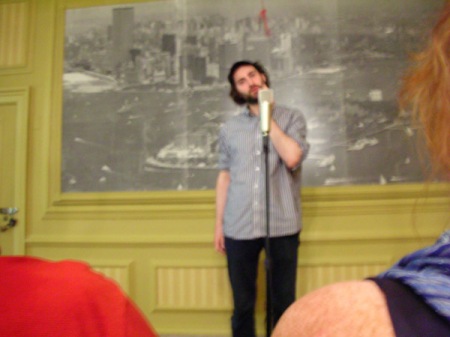
Action shot, too quick even for the camera. Photo by CAD.
The performance ended, predictably enough, with Vonna-Michell apologizing because he has run out of time, and of course his tale is nowhere near Governor’s Island. When I saw him later that afternoon as we were exploring other works included in Plot 09, the artist explained that it seemed appropriate that the commission was incomplete. Part of this was pragmatic: during the performance, and again in personal conversation afterwards, he admitted that the curator’s proposal of something like 10 performances in two days was a bit absurd considering he had done just four such performances in the previous year. But there was also an appropriate poetics to the cancelled final performance, suggesting a synecdochal relationship to the failure of each of the individual monologues to complete a story. Embodying a corollary relationship to larger mechanisms of history in process, what constitutes Vonna-Michell’s oeuvre remains a series of open-ended archives.
I highly recommend Martin Herbert’s introduction to Vonna-Michell’s work from the January issue of Artforum (Log-In required.). As I re-read it I found it dealt with almost all of the major ideas that I brought away from the Governor’s Island performance. Herbert points out the archival aspect of TVM’s project as well—certainly a theme of interest to me personally.
Also: X-Initiative’s Phase 2 opens today, and includes solo shows by Vonna-Michell, Keren Cytter and Luke Fowler. Each occupies an entire floor of the old Dia building.
On the one hand I am very excited about this, as what I have seen of each of these artists is impressive and makes me want to experience more for myself. But there is also a bit of the business as usual here that the cynical side of me wants to question. The press release goes to great lengths to point out that each of these artists has been included in major international biennial-type affairs. They’ve each received notable awards, received profiles in the major art magazines, etc.
When I first saw the line-up, my first thought was, “Oh—they were all in Younger than Jesus.” Granted, a full floor allows a very different presentation than the limited spaces allotted each at the New Museum, but when you remember that X Initiative curatorial director Cecilia Alemani is also the partner of Massimiliano Gioni (one of the curators of YTJ)… well, I’m ambivalent. Granted, X Initiative is working from a sort of ad-hoc model, with limited planning timelines and exhibition budgets, so it makes sense to present exhibitions heavy on ephemerality and video (low shipping costs). So I while I am excited to see the exhibitions and the potentially ambitious presentations from each artist, I do wish that X would take a greater risk.
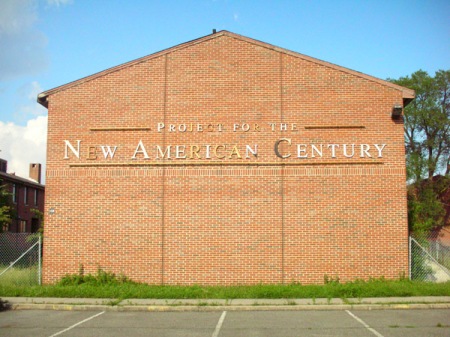
Tue Greenfort: Project for the New American Century
Spent a beautiful Sunday on Governors Island visiting Creative Time’s new quadrennial Plot, with the inaugural edition curated by Mark Beasley, This World and Nearer Ones. The highlight of the exhibition (although I didn’t see everything), and the reason I made sure to go opening weekend, was Tris Vonna-Michell’s performance. I’ll try to collect my thoughts on his “storytelling” and get something more substantial online later this week. In the meantime, a selection of photos on site. There are number of other decent works that didn’t photograph well, including a several sound pieces. For a full review, check Ms. Smith’s take. She calls for a re-evaluation of site-specificity.
Above is Tue Greenfort’s contribution, culled and cut from the interior of Brick Village, slated for re-development in the near future.
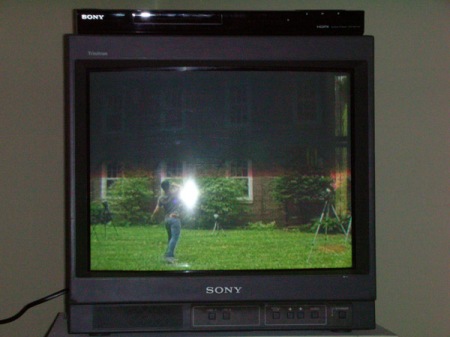
Tercerunquinto: Insular Act
Mexico City-based collective Tercerunquinto decided to through a rock through a second story window of building that is protected through historical preservation, capturing it through 10 video cameras. Their action was pre-approved, and the window was quickly replaced.
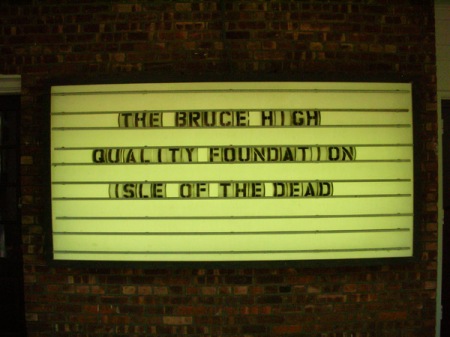
Bruce High Quality Foundation: Isle of the Dead
Merry pranksters BHQF contribute an art world zombie movie, filmed in and screening in the on-island movie theater. Good clean fun, complete with sing along.

AA Bronson and Peter Hobbs: Invocation of the Queer Spirits (Governors Island)
Inspect the remains of a Bronson/Hobbs seance, a ritual cleansing of historical wrongs. All male communities, marginalization, gays in the military. Plus taxidermy and dried underbrush.

AA Bronson and Peter Hobbs: Invocation of the Queer Spirits (Governors Island)
![tris_mccall [Left] Tris Vonna-Michell: Performance view, [Right] Anthony McCall: Between You and I](https://carefullyaimeddarts.files.wordpress.com/2009/06/tris_mccall.jpg?w=450&h=303)
(Left) Tris Vonna-Michell: Performance view, (Right) Anthony McCall: Between you and I

Teresa Margolles: Muro Balleado
Venice Biennale participant Margolles transplants a wall from her home town where drug-related shootings took place. File under site/non-site, bullet-ridden, supposedly bloodstained post-minimalism. Tags: Dislocation, border crossings, NAFTA, etc. Wonder if bullets are still in cinder blocks. Marvel at the fact the cinder blocks, the world round, are what most structures are constructed with.

Judi Werthein: La Tierra de los Libres
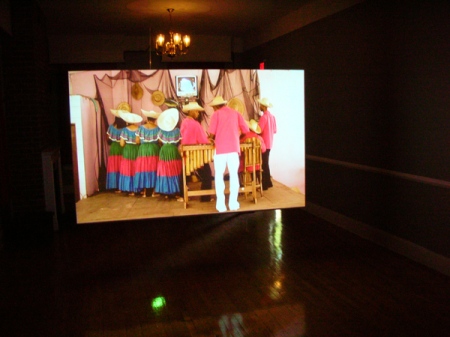
Judi Werthein: La Tierra de los Libres
Rural Colombians displaced by drug trade move to urban areas, are asked to perform literal translation of the Star-Spangled Banner, in their own style. Filmed (and projected) from both sides; English subtitles, literal translation of the Spanish version, included on rear. “You say, you can see, you say, you can see… Does the flag still wave over the home of the free? ”

Roger Fenton, Valley of the Shadow of Death, 1855; Courtesy Getty Museum
Often cited as the first war photographer, Roger Fenton was dispatched to photograph the Crimean War in 1855 at the behest of publisher Thomas Agnew. Documenting a widely unpopular military campaign, Fenton avoided turning his lens upon the destruction produced by the theater of war. The slow exposures and photographic technology of the time were prohibitive in freezing any motion and actions, making depiction of actual scenes of battle impossible. But whether by editorial bias or his general Victorian sensibilities, unlike his counterparts in the American Civil War, Fenton declined to make images of the dead and wounded. The resulting exhibition of photographs from over 300 wet plate negatives primarily depicted portraits of soldiers in camp, as well as the barren plains upon which they pitched their tents.
Fenton’s most famous photograph, Valley of the Shadow of Death, of which there are two exposures, was taken in the Crimea. A Martian landscape recedes before the camera, the packed dirt road winding to the distance, pocked by scattered cannonballs lying in the ruts and gutters. No tree breaks the horizon, no solitary figure wanders the road. For a photograph of a war zone it is remarkably silent; I imagine not the sound of cannon fire, but perhaps merely the low whistle of the wind. It is an image of a landscape devastated, admitting no life. Fenton adopted the soldiers’ name for the valley, evocative in its Biblical associations. The 21st century viewer might call to mind Cormac McCarthy’s apocalyptic settings in the American west.
This image has captivated subsequent historians and photographers alike (witness Errol Morris’s recent investigations into Fenton’s “stagecraft” of the photograph), so it is worth considering what about the image is noteworthy. As suggested earlier, Fenton’s work does not easily fit into a modern conception of war photography, marked as that genre is by notions of the event and action. Instead it is truly a landscape photograph, conforming to certain conventions, and suggestive of an archetypal quality even in its specific elements. It is exceedingly spare and elegantly composed, seeming to admit no extraneous details in order to communicate an idea of the landscape through a great economy of means. This restraint, I believe, is what makes the image so iconic. Thinking reductively, the contents of the picture can be cataloged thus: earth, horizon, road, cannonballs. Its very title speaks of death, and of an epic suffering, but also of divine faith (23rd Psalm).

Joe Deal, Road Cut (Homage to Roger Fenton) Diamond Bar, California, 1984; Courtesy Robert Mann Gallery, New York
Spare and understated, formally precise by with a minimum of inflection, and certainly depicting a “Man-Altered Landscape,” it comes as no surprise that Fenton’s picture was echoed over a hundred years later by one of the principal artists associated with the New Topographics style. Working on his surveys of suburban development in Southern California, Joe Deal made Road Cut (Homage to Roger Fenton) Diamond Bar, California, 1984.
Deal’s homage shares many of the same elements as Valley of the Shadow of Death, so it is illuminating to see where they differ, and how Deal’s citation of photographic history suggests the stakes of his own project. As with Fenton’s photograph, Deal’s relies on information provided by the title to endow the image with meaning, both in the invocation of Fenton and in the naming of the “road cut.” Deal replaces the cannonballs of the 19th century with the moist dirt clods of suburban development—his is not a landscape that bares witness to violence, it is a landscape under attack—the “cut” of the title a scar across a hillside, marked by human disturbance. In Fenton’s picture there are artifacts of violence whereas in Deal’s there are traces.
25 years after Deal plodded the subdivisions around Los Angeles, the political contexts of the work of Sophie Ristelhueber and Guy Tillim are considerably different, but they also make use of the iconic status of Fenton’s photograph in order to buttress their own notions of landscape and war.

Sophie Ristelhueber, WB #48, 2005; Courtesy Blancpain Art Contemporain, Geneva
Ristelhueber’s series WB depicts roadblocks in the West Bank. A number of photographs in the series resemble Valley of the Shadow of Death, but WB #48, 2005 most explicitly echoes the composition of Fenton’s picture. Like Deal’s photograph, cannonballs have been replaced by earthen matter, here rocks and boulders lining the road and finally piled into a barrier. If Deal’s image depicted a landscape disrupted by human development, here human action has folded the landscape back upon itself, negating the earlier action that created the road. But if it is a return it is hardly an innocent one. One hardly needs the presence of cannonballs to understand (again aided by the knowledge that this is the West Bank) that this is a contested landscape. In this sense we can also consider Ristelhueber’s well-known photographs of scarred human flesh to be landscape pictures.

Guy Tillim, Game of petanque, Porto Novo, Benin, 2007; Courtesy Michael Stevenson Gallery, Cape Town
Guy Tillim’s photograph Game of petanque, Porto Novo, Benin, 2007 comes from the series Avenue Patrice Lumumba. With this body of work Tillim photographed across Sub-Saharan Africa, where many avenues, streets and city squares are named after the assassinated leader who remains an icon of post-colonial nationalism. In many ways the citation and relationship of this image is an inversion of the negative connotations at play in the previous photographs. It shares many of the pictorial conventions again, but with significant reversals. Notably the landscape is urban, rather than suburban or rural, and depicts a person, barely encroaching on the edge of the frame to let us know this is a scene that is unquestionably populated and existing in a specific moment. Also of note is the motion blur of one of the petanque balls; whereas the photographs by Fenton and Ristelhueber suggest stasis, crucially this is a landscape as yet in motion, dynamic and unfolding in its potential. (Deal’s landscape seems a fresh wound, not entirely realized, and speaking of further disruptions to come.) While the cannons, dirt clods and roadblocks are explicit in their forms of violence, the petanque balls are much more ambiguous. On the one hand they evoke play and forms of conviviality and leisure. But also lurking is the subtext of colonialism, the game itself a legacy of French rule in Benin. For all of the promise and subsequent strife of post-colonial African politcs, this is a landscape still very much open to determination.
Each of the photographs by Deal, Ristelhueber and Tillim builds upon the citational politics of Fenton’s Valley of the Shadow of Death. But taken as a whole, they each propose politicized views of landscape through their pictorial means. At the heart of these images is the road, a social space constituted by bodies in transit. Formally it introduces depth, and according to a classical pictorial conception of landscape allows the viewer to follow a path into the picture, and ultimately into the world created by the camera. In Fenton’s version (and according to his narration of the day) the road was too dangerous to admit passage. Deal’s subdivision speaks of the inevitability of more roads, more houses, and more development, and eventually those families who will make their homes there. Ristelhueber’s landscape has already foreclosed admission; it denies movement to marked bodies. Finally, Tillim shows a public space still carrying the legacy of its past, but with a potential for advancement into the future, a battlefield morphed into a public space of convergence. Each picture is therefore a question of passage and the politics of movement within a landscape: at the most basic, who can go where? It is a small leap to then consider border disputes as well as notions of property and sovereignty, urban planning and ecology, as being related to notions of landscape. In introducing questions of violence and access into the discussion of landscape, we can begin to examine the political potential of the genre.
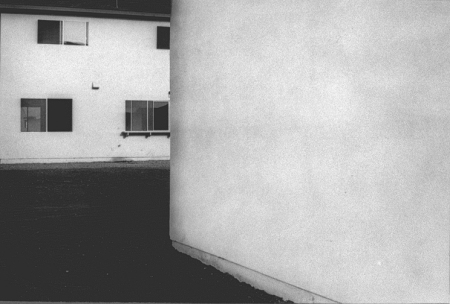
Lewis Baltz, "Tract House #6, 1971"
Those who spend their caffeine-fueled dawns and beer-thirsting dusks swaying along the New York MTA subway organs are no doubt familiar with the quote, “History is like that, very chancy,” from the intrepid Samuel Eliot Morison, he of the Trains of Thought ad series lining train interiors. Which is a roundabout way to introduce that unlikely touchstone in the history of photography, the now seminal (gender appropriate) exhibition New Topographics: Photographs of a Man Altered Landscape that opened in 1975 at the George Eastman House in Rochester, New York. Featuring Robert Adams, Lewis Baltz, Bernd and Hilla Becher, Joe Deal, Frank Gohlke, Nicholas Nixon, John Schott, Stephen Shore, and Henry Wessel, the exhibition became the brand name for a full-blown genre of photographic investigation.
Twenty-four years later, the exhibition is being recreated, and curators Britt Salvesen of the Center for Creative Photography and Alison Nordstrom of George Eastman House clearly have an art historical ax to grind. The press release is full of lofty prose and direct rhetoric. A selection of excerpts:
Arguably the last traditionally photographic style, New Topographics was also the first photoconceptual style…
As evidence of its influence, it is considered the second most-cited photography exhibition in the history of the medium… (Aside: What’s the first? Family of Man? Update: Upon further consideration, probably New Documents.)
The influence of New Topographics can be traced by looking again at the original pictures and at the circumstances in which the 10 artists were brought together. At the core of this re-examination will be the works from the 1975 show, which was curated by William Jenkins in collaboration with the artists. Jenkins’s concept achieved currency primarily through the exhibition catalogue (which today is being sold at rare-book sales for upwards of $1,000, far beyond its original $6.95 price tag). “By revisiting the photographs, we can assess their cumulative effect and consider their impact as objects,” Salvesen said. “This reprise also provides a unique opportunity to assess the original exhibition’s aims, consider its influence on young photographers today, and examine the international implications of an American impulse in photography.”
This presentation of New Topographics will also include prints and books by other relevant artists to provide additional historical and contemporary context. Timothy O’Sullivan appears in his role as a 19th-century precursor cited by both Adams and Baltz, while Walker Evans illustrates the idea of “documentary style” that he introduced to American photography in the 1930s. The conceptual aspect of New Topographics is illuminated by the photo-based books of Ed Ruscha, a key figure in Jenkins’s catalogue essay; Robert Smithson’s Instamatic snapshots of defiantly anti-monumental sites; and Dan Graham’s magazine layout/slide show Homes for America; and the groundbreaking 1972 study Learning from Las Vegas, by Robert Venturi, Denise Scott Brown, and Steven Izenour.
In the coming weeks and months I hope to examine many of the topics and concerns that the exhibition raises, including the following:

Frank Gohlke, "Grain elevators, Minneapolis, 1974"
My interest in New Topographics is largely personal. Raised in the West, I was imbued with a certain reverence for the natural world, but a Romanticism leavened by pragmatism and eventually cynicism. My own journey through photography retraced the steps of many of the Topographic photographers, rejecting the sublime landscapes that came before me, the equivalences and transcendentalisms that defined American photography for at least half a century. Even as I no longer make pictures of my own, I certainly see photographs as codifications of social values. No image is innocent or blank: they each belie a world of biases and valuations. In framing the world they saw developing before them, the Topographic photographers gave form to ideas they had about the landscapes they lived in. Landscape, as a physical thing in a world, but more particularly through their aesthetic representation, tell us a great deal about who we are.
In the interests of full disclosure, outside of this blog I have professional relationships with several of the photographers in the exhibition; I hope that if anything this will clarify and illuminate certain ideas rather than cloud them–my intentions certainly aren’t promotional in this setting.
I’ve laid the groundwork with a lot of questions that have been stirring in my head over the past months since I learned about the forthcoming exhibition. New Topographics will be touring for the next three years, so this may be a discussion that comes and goes. The publication is slated to arrive in September.
George Eastman House (June 13–Oct. 4,2009); Los Angeles County Museum of Art (Oct. 25, 2009–Jan. 3, 2010); Center for Creative Photography (Feb. 19–May 16, 2010); San Francisco Museum of Modern Art (July 17–Oct. 3, 2010); Landesgalerie Linz, Austria (Nov. 10, 2010–Jan. 9, 2011), Photographische Sammlung Stiftung Kultur, Cologne (Jan. 27–April 3, 2011); Jeu de Paume, Paris (April 11–June 12, 2011); and the Nederlands Fotomuseum Rotterdam, the Netherlands (July 2–Sept. 11, 2011); and Bilbao Fine Arts Museum, Bilbao (November 2011–January 2012).
Historical Erasure Follow-Up: Holland Cotter
May 31, 2009In the Saturday NY Times recent Pulitzer Prize winning critic Holland Cotter addresses some of the “history” issues concerning the Met’s Pictures Generation that I brought up in the previous post:
Kudos to Cotter for bringing this to the fore. I assumed that he won the Pulitzer mostly for his feature-style criticism from China leading up to the Olympics, and this article works in the same vein. Cotter discusses two shows that he has already previously reviewed for the Times, and considers the ways in which exhibitions, rather than serving as objective truths, are involved in their own form of historical production and narrativization. In this sense it foregrounds the curatorial responsibility (and imperative) in establishing a context for making meaning.
The article compares the roles of history making in the Pictures Generation and the New Museum’s Younger than Jesus. Interestingly, the web version of the Cotter’s text is illustrated with Elad Lassry’s photographs, whose films I have written about previously. Although Lassry goes unmentioned in Cotter’s article, and his review of YTJ, it is an appropriate editorial decision as Lassry very deliberately engages the forms of production and aesthetic strategies laid out by Pictures artists, making explicit the connection between the two shows. In particular Lassry has a strong connection, even reconsideration, of Jack Goldstein’s motifs, buttressed by the work of Sarah Charlesworth and Dara Birnbaum and David Salle and James Welling. While I am obviously interested in Lassry’s work, I think it fares poorly in YTJ; a lot of this has to do with context and installation: his photographs are small and intensely formal, and in the slapdash cacophony of the third floor, they are almost easy to miss. The side gallery in which they hang is shared with Matt Keegan’s work, presumably because they both engage the Pictures legacy (Keegan with Barbara Kruger explicitly referenced), but it is to the detriment of Lassry’s presentation. Though I won’t go into it here, I had problems with the installation throughout YTJ.
UPDATE: Several weeks before Cotter or I wrote about this, Regina Hackett, also quoting CultureGrrl, posted about Smith’s exclusion. I had also read the AiA interview she cites, and it was influencing my thoughts, but I couldn’t remember the source of the “qualitative exclusion”. To reiterate, it seems like it would have been a minor thing to include Smith in such a sprawling show, and also satisfied historical accuracy.
Tags: Elad Lassry, Holland Cotter, Philip Smith, Pictures Generation, Younger than Jesus
Posted in Media Commentary | 3 Comments »